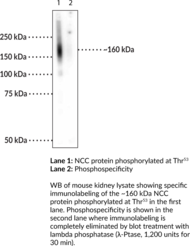Description
The thiazide-sensitive sodium chloride cotransporter (NCC) is a member of the SLC12 family of transporters and is encoded by SLC12A3 in humans.{46961} NCC is expressed in epithelial cells of the distal convoluted tubule and localizes to the apical plasma membrane where it mediates sodium reabsorption in the kidney. It consists of a central hydrophobic domain with 12 transmembrane helices that contain affinity-modifying residues for sodium, chloride, and thiazides that is flanked by intracellular N- and C-terminal domains with sites that are subject to phosphorylation. Phosphorylation of NCC at threonine 53 (Thr53) is mediated by serum- and glucocorticoid-inducible kinase 1 (SGK1), STE20/SPS1-related proline-alanine-rich protein kinase (SPAK), or oxidative stress-responsive kinase 1 (OSR1). X. laevis oocytes expressing a threonine-to-alanine substitution at Thr53 in NCC, which abolishes its phosphorylation, have reduced chloride deprivation-induced sodium uptake, but not NCC surface expression, compared to wild-type oocytes.{46963} NCC (phospho-Thr53) levels are increased in the kidney by low dietary intake of sodium chloride or potassium in mice.{46962} NCC (phospho-Thr53) levels are also increased in the kidney of the CUL3-Het/∆9 mouse model of familial hyperkalemic hypertension.{46964} Cayman’s NCC (Phospho-Thr53) Polyclonal Antibody can be used for immunofluorescence (IF) and Western blot (WB) applications. The antibody recognizes NCC (phospho-Thr53) at approximately 160 kDa from human, mouse, and rat samples.
Synonyms: Sodium Chloride Symporter
Immunogen: Phosphopeptide corresponding to amino acid residues surrounding the phospho-Thr53 of mouse NCC
Formulation: 100 µl of affinity-purified rabbit polyclonal antibody
Isotype:
Applications: IF and WB
Origin:
Stability: 365 days
Application|Immunofluorescence||Application|Western Blot||Product Type|Antibodies|Polyclonal Antibodies||Research Area|Cardiovascular System|Cardiovascular Diseases|Hypertension||Research Area|Cardiovascular System|Kidney & Renal Disease




